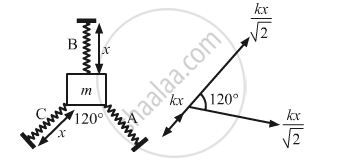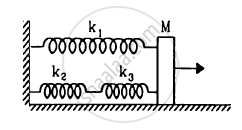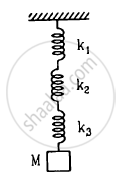Advertisements
Advertisements
Question
Repeat the previous exercise if the angle between each pair of springs is 120° initially.
Solution
As the particle is pushed against the spring C by the distance x, it experiences a force of magnitude kx.

If the angle between each pair of the springs is 120˚ then the net force applied by the springs A and B is given as,
\[\sqrt{\left( \frac{kx}{2} \right)^2 + \left( \frac{kx}{2} \right)^2 + 2\left( \frac{kx}{2} \right)\left( \frac{kx}{2} \right) \cos 120^\circ} = \frac{kx}{2}\]
Total resultant force \[\left( F \right)\] acting on mass m will be,
\[F = kx + \frac{kx}{2} = \frac{3kx}{2} \]
\[ \therefore a = \frac{F}{m} = \frac{3kx}{2m}\]
\[ \Rightarrow \frac{a}{x} = \frac{3k}{2m} = \omega^2 \]
\[ \Rightarrow \omega = \sqrt{\frac{3k}{2m}}\]
\[ \therefore \text { Time period }, T = \frac{2\pi}{\omega} = 2\pi\sqrt{\frac{2m}{3k}}\]
APPEARS IN
RELATED QUESTIONS
A particle executes simple harmonic motion with an amplitude of 10 cm. At what distance from the mean position are the kinetic and potential energies equal?
The maximum speed and acceleration of a particle executing simple harmonic motion are 10 cm/s and 50 cm/s2. Find the position(s) of the particle when the speed is 8 cm/s.
Consider a particle moving in simple harmonic motion according to the equation x = 2.0 cos (50 πt + tan−1 0.75) where x is in centimetre and t in second. The motion is started at t = 0. (a) When does the particle come to rest for the first time? (b) When does he acceleration have its maximum magnitude for the first time? (c) When does the particle come to rest for the second time ?
The pendulum of a clock is replaced by a spring-mass system with the spring having spring constant 0.1 N/m. What mass should be attached to the spring?
In following figure k = 100 N/m M = 1 kg and F = 10 N.
- Find the compression of the spring in the equilibrium position.
- A sharp blow by some external agent imparts a speed of 2 m/s to the block towards left. Find the sum of the potential energy of the spring and the kinetic energy of the block at this instant.
- Find the time period of the resulting simple harmonic motion.
- Find the amplitude.
- Write the potential energy of the spring when the block is at the left extreme.
- Write the potential energy of the spring when the block is at the right extreme.
The answer of b, e and f are different. Explain why this does not violate the principle of conservation of energy.

The springs shown in the figure are all unstretched in the beginning when a man starts pulling the block. The man exerts a constant force F on the block. Find the amplitude and the frequency of the motion of the block.

Solve the previous problem if the pulley has a moment of inertia I about its axis and the string does not slip over it.
A rectangle plate of sides a and b is suspended from a ceiling by two parallel string of length L each in Figure . The separation between the string is d. The plate is displaced slightly in its plane keeping the strings tight. Show that it will execute simple harmonic motion. Find the time period.

Find the elastic potential energy stored in each spring shown in figure when the block is in equilibrium. Also find the time period of vertical oscillation of the block.

Show that for a particle executing simple harmonic motion.
- the average value of kinetic energy is equal to the average value of potential energy.
- average potential energy = average kinetic energy = `1/2` (total energy)
Hint: average kinetic energy = <kinetic energy> = `1/"T" int_0^"T" ("Kinetic energy") "dt"` and
average potential energy = <potential energy> = `1/"T" int_0^"T" ("Potential energy") "dt"`
If a body is executing simple harmonic motion and its current displacements is `sqrt3/2` times the amplitude from its mean position, then the ratio between potential energy and kinetic energy is:
A body is executing simple harmonic motion with frequency ‘n’, the frequency of its potential energy is ______.
A body is executing simple harmonic motion with frequency ‘n’, the frequency of its potential energy is ______.
Displacement versus time curve for a particle executing S.H.M. is shown in figure. Identify the points marked at which (i) velocity of the oscillator is zero, (ii) speed of the oscillator is maximum.

Draw a graph to show the variation of P.E., K.E. and total energy of a simple harmonic oscillator with displacement.
An object of mass 0.5 kg is executing a simple Harmonic motion. Its amplitude is 5 cm and the time period (T) is 0.2 s. What will be the potential energy of the object at an instant t = `T/4` s starting from the mean position? Assume that the initial phase of the oscillation is zero.
